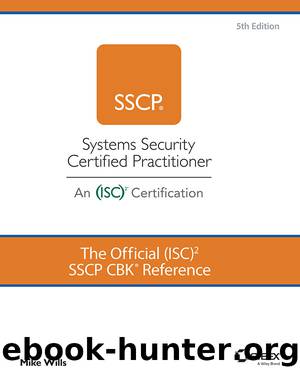The Official (ISC)2 SSCP CBK Reference by Mike Wills

Author:Mike Wills
Language: eng
Format: epub
ISBN: 9781119602002
Publisher: Wiley
Published: 2019-10-29T16:00:00+00:00
This is shown with small values for all numbers in Figure 5.11.
FIGURE 5.11 Diffie-Hellman-Merkle shared key generation (conceptual)
What about Eve, sitting along the sidelines of this conversation? Suppose Eve is, well, eavesdropping on Bob and Carol’s key exchange; she somehow is trapping packets going back and forth and recognizes that they’ve agreed to an algorithm and its control parameters; she recognizes the exchange of Bob’s and Carol’s public keys for what they are. As long as Eve does not have a secret key that participated in the computation of the session key, she does not have anything that lets her read the traffic that Bob and Carol encrypt with the session key. Eve is left to using brute-force, side channel, or other attacks to attempt to break the session encryption.
Ted, on the other hand, is someone Bob and Carol want to include in a three-way secure conversation (still keeping Eve out in the cold, of course). The process previously shown in steps 1 through 5 can easily be expanded to include three or more parties who share the choices about algorithms and parameters, who then compute their own public keys and share them; they then use everybody else’s public keys to compute their own copy of the session key.
Obviously, this simplified description of the Diffie-Hellman key exchange process has some vulnerabilities. It doesn’t actually authenticate that Bob is Bob, or Carol is Carol, thus tempting Ted to be the “man in the middle” who masquerades to be the other party from the initial handshake and key generation through to the end of the session. The choice of trapdoor function, and the control values for it, can also present exploitable vulnerabilities. But in its simplest form, this is where the public key infrastructure (PKI) got its start.
Building a public key infrastructure starts with the algorithms used to generate the shared secret keys used to establish trustworthy communications. Those algorithms have to be implemented in some combination of software and hardware, which are then made available to users to incorporate into their systems or use as standalone messaging apps. These apps themselves and the software and hardware distribution channels (wholesale, retail, original equipment manufacturer (OEM), or other) all have to be part of a network of trust relationships if two end users are going to trust in such apps to protect their communication with each other. Thus, the problem of building a public key infrastructure must also embrace the problem of trusted software (and hardware) distribution and update. This will be explored further in the “Understand Public Key Infrastructure Systems” section of this chapter.
Download
This site does not store any files on its server. We only index and link to content provided by other sites. Please contact the content providers to delete copyright contents if any and email us, we'll remove relevant links or contents immediately.
Kotlin in Action by Dmitry Jemerov(17181)
Grails in Action by Glen Smith Peter Ledbrook(15388)
Sass and Compass in Action by Wynn Netherland Nathan Weizenbaum Chris Eppstein Brandon Mathis(13262)
Azure Containers Explained by Wesley Haakman & Richard Hooper(7499)
Configuring Windows Server Hybrid Advanced Services Exam Ref AZ-801 by Chris Gill(7496)
Running Windows Containers on AWS by Marcio Morales(7051)
Microsoft 365 Identity and Services Exam Guide MS-100 by Aaron Guilmette(5434)
Microsoft Cybersecurity Architect Exam Ref SC-100 by Dwayne Natwick(5272)
Combating Crime on the Dark Web by Nearchos Nearchou(5017)
The Ruby Workshop by Akshat Paul Peter Philips Dániel Szabó and Cheyne Wallace(4701)
Management Strategies for the Cloud Revolution: How Cloud Computing Is Transforming Business and Why You Can't Afford to Be Left Behind by Charles Babcock(4546)
Python for Security and Networking - Third Edition by José Manuel Ortega(4273)
The Age of Surveillance Capitalism by Shoshana Zuboff(4243)
Learn Wireshark by Lisa Bock(4175)
Learn Windows PowerShell in a Month of Lunches by Don Jones(4066)
The Ultimate Docker Container Book by Schenker Gabriel N.;(3919)
Ember.js in Action by Joachim Haagen Skeie(3660)
DevSecOps in Practice with VMware Tanzu by Parth Pandit & Robert Hardt(3608)
Windows Ransomware Detection and Protection by Marius Sandbu(3576)
